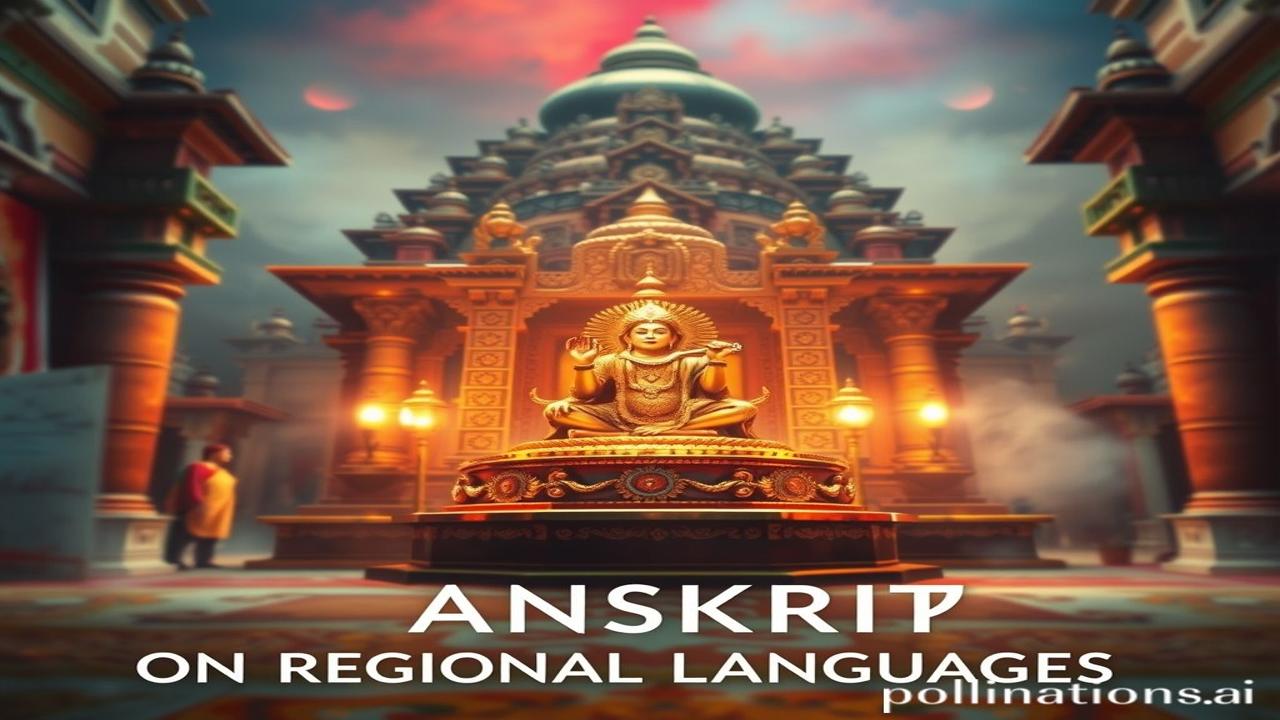Okay, let’s dive into this!
Waqt ki Dhool aur Sanskrit ki Mehak: Unveiling the Language That Breathed Life into Bharat
Kabhi socha hai, jab aap apne maa-baap, dada-dadi se baat karte hain, kitne aise shabd hote hain jo dil ko choo jaate hain? Woh shabd, jo humari zubaan par aise phisal jaate hain jaise koi nadi pahadon se utar rahi ho. These words, often unknowingly, carry the scent of ancient Sanskrit. Imagine walking down a narrow lane in Varanasi, the air thick with incense and the sound of chanting. That feeling of connection, of something deeply rooted in our past, is often whispered in the echoes of Sanskrit within our regional languages.
Sanskrit: The Mother Language and Its Sons and Daughters
Sanskrit. The very name evokes images of ancient rishis, elaborate rituals, and profound philosophical texts. But it’s much more than just a language of the past. It’s the janani – the mother – from whom so many of our beautiful regional languages have sprung.
Think of Sanskrit as a giant, ancient tree. Its roots run deep into the soil of ancient India, dating back thousands of years. From this tree, branches have grown, blossomed, and borne fruit. These fruits are the regional languages we speak today: Hindi, Marathi, Bengali, Gujarati, Tamil, Telugu, Kannada, Malayalam, and countless others.
This wasn’t an overnight process. It unfolded over centuries, with Sanskrit acting as a lingua franca for scholars, priests, and rulers across the Indian subcontinent. From around 1500 BCE onwards, with the arrival of Indo-Aryan speakers, Sanskrit began to shape the linguistic landscape. Different Prakrits evolved, gradually diverging into the regional languages we know and love.
Zameeni Sach: Life Before Google Translate
Imagine life in ancient India. A king addresses his court in Sanskrit, his words echoing through the halls. “Dharma ki raksha karna humara kartavya hai,” he declares, emphasizing the importance of righteousness. Artisans craft intricate sculptures, chanting mantras learned in Sanskrit. Farmers pray to Surya Dev, reciting Sanskrit hymns for a bountiful harvest.
Think of a young scholar named Madhav. He travels from village to village, sharing knowledge encoded in Sanskrit texts. He translates and interprets the verses for the common people, weaving the essence of Sanskrit into their daily lives. He teaches them about moksha, karma, and dharma, using local dialects to explain complex philosophical concepts.
Ma Rukmini ne aaj naye kapde pehne, kyunki mandir mein utsav tha. The air buzzed with excitement as villagers prepared for the puja, reciting familiar Sanskrit mantras. The scent of agarbatti mingled with the sweet aroma of offerings. For them, Sanskrit wasn’t just a language; it was a lifeline to the divine.
Dharohar aur Pehchan: Sanskrit in Modern India
Today, the influence of Sanskrit is everywhere, often hiding in plain sight. The words we use, the rituals we perform, the stories we tell – all bear the imprint of this ancient language.
Look at Hindi, for instance. Words like prakriti (nature), sanskriti (culture), samaj (society), vidya (knowledge), shanti (peace) – they all trace their roots back to Sanskrit. The same is true for countless other regional languages. Even in Tamil, which has a rich and independent history, Sanskrit loanwords have found their way into the lexicon, enriching its expressive power.
Our festivals, like Diwali, Holi, and Navratri, are steeped in Sanskrit traditions. The mantras chanted during pujas, the stories narrated during kathas, the art and architecture of our temples – they all speak to the enduring legacy of Sanskrit in our lives. It’s a vital thread in the fabric of Bharatiyata, shaping our identity and connecting us to our ancestors.
Mazedar Tathya: The Silent Revolution
Log samajhte hain ki Sanskrit sirf panditon ki bhasha thi, lekin asli sach yeh hai that it played a vital role in the development of grammar and linguistics. Panini’s Ashtadhyayi, a groundbreaking work on Sanskrit grammar written around the 4th century BCE, is considered to be one of the earliest and most comprehensive treatises on language structure ever created. It influenced scholars worldwide and laid the foundation for modern linguistics.
Another myth? That Sanskrit is a “dead” language. While it’s not widely spoken as a first language, it continues to be used in religious ceremonies, scholarly research, and even in modern technology. Efforts are underway to revive Sanskrit and make it more accessible to a wider audience.
Drishya aur Bhavnayein: The Temple Whispers
Imagine standing before a magnificent temple, its walls adorned with intricate carvings depicting scenes from the Ramayana and Mahabharata. The air smells of sandalwood and ghee, the sound of bells and chanting fills the air. Run your hand across the cool stone of the temple walls. You can almost feel the energy, the shakti, that has accumulated over centuries of devotion. These temples, these rituals, these sounds – they are all testaments to the enduring power of Sanskrit.
Antim Vichar: A Timeless Echo
Sanskrit, the ancient mother of so many tongues, continues to whisper in our ears, reminding us of our shared heritage. Its influence is not just linguistic; it’s cultural, philosophical, and spiritual.
“Vasudhaiva Kutumbakam” – The world is one family. This timeless Sanskrit phrase encapsulates the spirit of unity and interconnectedness that lies at the heart of Indian philosophy. May we continue to cherish and preserve this precious linguistic and cultural treasure for generations to come.
